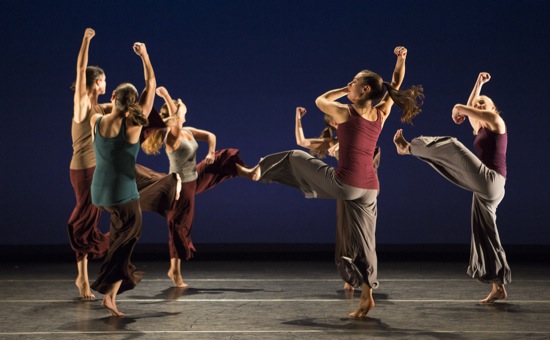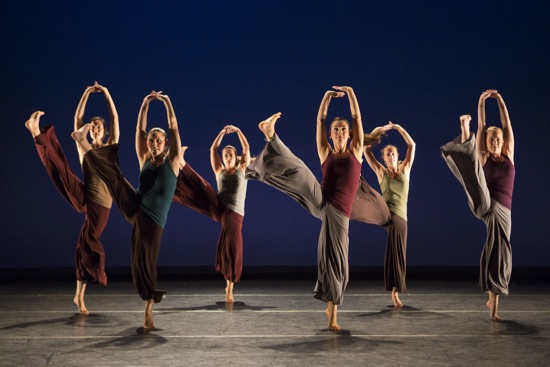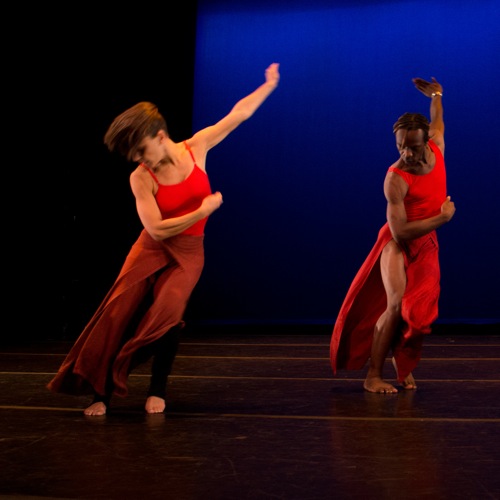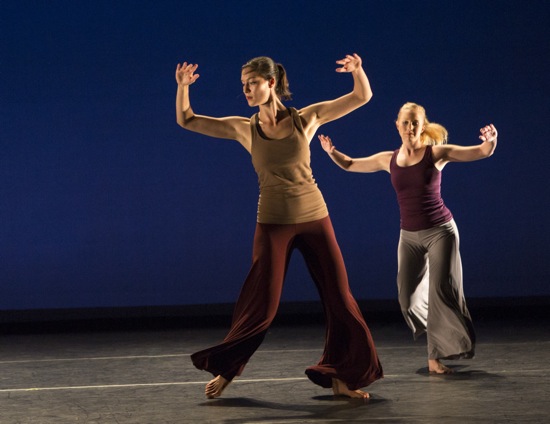Tina Croll + Company performs in New York with Zlatne Uste Balkan Brass Band.

Members of Tine Croll + Company perform Croll’s Balkan Dreams. Photo: Whitney Browne
I haven’t seen Tina Croll’s choreography for quite a while, although she and I were early members of Dance Theater Workshop, and I’ve performed in several versions of From the Horse’s Mouth, a structured improvisation involving text and dance that she devised with Jamie Cunningham (there’s one coming up in honor of Gus Solomons, jr April 1-3 at the 14th Street Y).
I knew of Croll’s ongoing delight in Balkan folk dance and its music, but her company’s performances in 92Y’s ongoing Harkness Dance Festival this past weekend made it clear just how deeply that interest has affected her own choreography. I can’t remember ever having my own feet heeling and toeing against the floor while I’m sitting in a chair watching a dance concert. At the Friday performance, nine members of the Zlatne Uste Balkan Brass Band are ranged behind the audience on Buttenweiser Hall’s tiny stage, their gold instruments gleaming. They play us in, they play live for one of the dances, they play whenever there’s a pause between numbers, and, after grabbing some wine and fruit at the reception in the lobby afterward, they go back into the hall and play for whoever wants to join the chain.
The five pieces on the program date from 1995 to Croll’s latest, in-progress work and all make intrepid use, in slightly different ways, of elements of Eastern European folk dance, while altering or expanding them. For instance, the women dancers often hold hands in a chain and travel with the “grapevine” step; they form circles or lines; they run with their arms around one or two partners’ waists; they stamp their feet, turning their legs in and out as their heels strike the floor or their knees lift. They also spin, both in place and traveling. In certain of the dances, they prance, leap, kick their legs high, and make expressive gestures, but there are no complex phrases of movement, and, whatever the music, a beat usually propels them.

(L to R): Victoria Dombrowski, Michelle Durante, Erin Pellecchia, Erin DeLucia-Benson, Michelle Gilligan, and Alexandra Mount-Campbell. Photo: Whitney Browne.
The Stamping Ground (2009) begins with an eeriness born of practicality. In dim light, the six women in Croll’s company plus eight guest dancers emerge through a slit in the black rear curtains that conceal a door and the studio behind it. Hand in hand as they snake in, they make you believe their progression is endless—that there could be fifty dancers back there. All are wearing black, variously styled outfits, and they dance to the recorded music of Abdelli (the Berber musician, I assume; I heard a plucked instrument and something like a kazoo) and Zlatne Uste playing traditional music from Romania. The women are very grave, as if this were a ritual, not a party. But they flock and race in big curving paths—almost as if wind-tossed— as well as traveling in lines and circles. Sometimes, when they turn, they bend low, and once, almost all lie down and sleep, while two walk among them.
Walkabout (1995) is a duet for Michelle Durante and Dale Harris, the only male dancer on the program. This is no amorous encounter. To an unspecified percussion piece by John Cage, they too dance briefly hand-in-hand and in unison; they too spin in place; they too stamp their feet in rhythm. Although they move in separate paths around a big circle, they also stand face to face and have an amiable argument in gestures, before walking out a side door with their arms around each other. They’ve found common ground.

Michelle Durante (L) and Dale Harris in Tina Croll’s Walkabout. Photo: Klaus Lucka
I’m gradually becoming aware of something that gets more evident as the program progresses. As I’ve said, most the music, whether live or recorded, whether traditional or contemporary, emphasizes infectious rhythms, and the choreography copies its patterns, stressing the downbeats and mirroring the beginnings of each new melody. That’s how folk dancing operates, even when the meters are as tricky as that of Balkan music. But Croll is not showing us folk dance per se. So I find myself wishing the dancers would occasionally delay, override, or otherwise more markedly vary their responses to the pulse.
She Rides a Tiger (2012) is set to less emphatic music by Arvo Pärt with its typically sweet harmonies. It opens with dull drum beats, and at one point voices loom within it. The six women (Erin DeLucia-Benson, Victoria Dombrowski, Michelle Gilligan, Alexandra Mount-Campbell, Erin Pellecchia, and Durante) wear simple gray dresses and begin walking backward in circles, looking upward. They are solemn in this dance too—running in slow motion. When they face us, they gaze beyond us (not all of them as intently as they could). They touch the floor; they touch their heads in different calm ways. There’s a hint of surrounding danger as the energy builds. Having rushed together to one corner of the space, they back away from it pulling air down with their hands.
From this point in the program, the mood lifts. For One Rhinoceros, 3 Birds and a Pineapple, the six dancers wear their hair in ponytails, and Patti Gilstrap has costumed them in dresses irregularly patched in brown and red. The five eclectic selections of recorded music begin with Meredith Monk’s vocalizations from her Travellers 1,2,3 and end with traditional music from Macedonia (after passing through a song in French by Paris Combo). In this work-in-progress, Croll shows some of the traditional steps and patterns mentioned, but also suggests a trek through a changing landscape. Dombrowski, Gilligan, DeLucia, and Pellecchia gather at what might be a well and scoop up water in their hands. All six press together belly-to-back and travel as a human caterpillar. They also bond temporarily to move along in trios. Durante and Gilligan have a silent argument, but enjoy it enough to take hands and walk away together. The movement vocabulary expands to include lying, sitting, and stopping in push-up positions. At the end, in what I think may be an allusion to a much earlier work of Croll’s, Dombrowski re-enters wearing a white constructivist rhinoceros head, takes it off, divests herself of a shabby knapsack, opens it and ta-da! takes out a pineapple. Lo, the title illustrated in seconds.

Victoria Dombrowski (center) and Alexandra Mount-Campbell in Balkan Dreams. Photo: Whitney Browne
Now Zlatne Uste, the band that’s been keeping us happy all evening, bursts into music from Bulgaria, Macedonia, and Romania, in order to accompany excerpts from Croll’s 2002 Balkan Dreams. The dancers’ movements get more spacious, and they finally begin to enjoy themselves, to smile at the pleasure of being together in this endeavor. They move in and out of the action, meet, join, separate, jump, and leap in different light-footed ways.
There’s a surprise. Three gray-haired men (Bard Rosell, Noel Kropf, and Tzvi Steinhauer) have been watching the women. Onto the floor they step, clad identically in black trousers and white shirts. Side by side, holding one another’s shoulders or belts, they dance—first a traditional Floricica and bit later a Ludo Kopano. Of different ages and different degrees of nimbleness, they provide the most intricate rhythmic footwork of the evening. Their feet twist in and out at daredevil speed while their bodies remain calm and erect. Croll has incorporated them into what the women began and will finish. If you couldn’t have guessed what drew her to Balkan folk dancing, you’d know by now. Its intrepid physical language and community spirit can not only inspire choreography; they can lighten your life.
